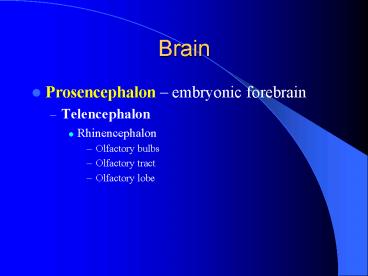Brain - PowerPoint PPT Presentation
1 / 62
Title:
Brain
Description:
Cerebral Peduncles motor tracts. Cerebral Aqueduct for CSF ... Cerebral peduncle. Cerebellum. Cerebrum. Key Points. Name the 12 cranial nerves in order. ... – PowerPoint PPT presentation
Number of Views:145
Avg rating:3.0/5.0
Title: Brain
1
Brain
- Prosencephalon embryonic forebrain
- Telencephalon
- Rhinencephalon
- Olfactory bulbs
- Olfactory tract
- Olfactory lobe
2
(No Transcript)
3
(No Transcript)
4
Key Points
- Identify the meaning of rhin- and olfactory.
5
Brain - Prosencephalon
- Telencephalon
- Cerebral hemispheres
- Paleostriatum primary region in fish, primarily
involved with olfactory reflexes - Neostriatum beginning with reptiles, more
complex and paleostriatum becomes buried - Hyperstriatum primarily in birds responsible
for stereotypical behavior such as migration,
courting, nesting
6
(No Transcript)
7
Brain - Prosencephalon
- Telencephalon
- Cerebral hemispheres Cerebrum
- Corpus striatum Basal nuclei remnants of
paleostriatum buried in mammalian brain,
responsible for stereotyped repetitive
movements - Cortex starting with reptiles, billions of
neurons that must be folded to fit in skull in
mammals
8
(No Transcript)
9
(No Transcript)
10
Cerebral Cortex
- Voluntary movement (motor)
- Conscious sensations (sensory)
- Memory
- Integration (decisions)
- 4 lobes according to skull bones
11
(No Transcript)
12
Brain - Prosencephalon
- Telencephalon
- Lateral Ventricles
- Cavities in brain that contain
- Cerebrospinal fluid (CSF)
- Formed from blood vessels called choroid plexus
- Circulates around CNS providing cushion,
protection, nutrients
13
(No Transcript)
14
Cerebrum Comparisons
15
(No Transcript)
16
(No Transcript)
17
(No Transcript)
18
Brain - Prosencephalon
- Diencephalon
- Epithalamus - Pineal body is light receptor in
agnathans endocrine in gnathostomes - Thalamus intermediate mass/adhesion sensory
relay - Hypothalamus optic chiasma, infundubular stalk
for pituitary gland functions as endocrine,
regulates ANS, emotions, water balance,
thermostat, hunger, satiety
19
(No Transcript)
20
(No Transcript)
21
(No Transcript)
22
(No Transcript)
23
Diencephalon
- Third Ventricle carries CSF
- Enters from Lateral ventricle via the
interventricular foramen - Exits to Fourth ventricle via the cerebral
aqueduct
24
(No Transcript)
25
Brain
- Mesencephalon embryonic midbrain, but term used
in adult too - Optic lobes especially well developed in birds
- Auditory lobes auditory reflexes
- Corpora Quadrigemina
- Cerebral Peduncles motor tracts
- Cerebral Aqueduct for CSF gtamphibians
26
Key Points
- What does the term corpora quadrigemina mean?
- What structures are included in the corpora
quadrigemina that you learned in lab?
27
(No Transcript)
28
(No Transcript)
29
(No Transcript)
30
(No Transcript)
31
Brain
- Rhombencephalon Embryonic hindbrain
- Myelencephalon
- Medulla oblongata
- Pyramids crossing of sensory motor tracts
- Vital reflexes such as breathing, connection
between brain spinal cord for ascending
descending pathways
32
(No Transcript)
33
(No Transcript)
34
(No Transcript)
35
Brain - Rhombencephalon
- Metencephalon
- Cerebellum Coordination balance, quite large
in birds mammals - Pons bridge between parts of brain
- Fourth Ventricle carries CSF
36
(No Transcript)
37
(No Transcript)
38
(No Transcript)
39
(No Transcript)
40
Key Points
- What is the root enceph?
- Pro? Tel? Di? Mes? Met? Myel? Rhomb?
41
Cranial Nerves See Cr. N. Page
- I. Olfactory Nerve Sensory only for smell
- II. Optic Nerve Sensory only for vision
- III. Oculomotor Nerve Motor to intrinsic
extrinsic eye muscles
42
(No Transcript)
43
(No Transcript)
44
(No Transcript)
45
(No Transcript)
46
Cranial Nerves
- IV. Trochlear Nerve motor to extrinsic eye
muscles - V. Trigeminal nerve mixed nerve, motor to
mastication pharyngeal arch muscles, sensory to
nose mouth - VI. Abducens nerve motor to extrinsic eye
muscles
47
(No Transcript)
48
(No Transcript)
49
(No Transcript)
50
(No Transcript)
51
Cranial Nerves
- VII. Facial Nerve motor to facial muscles,
salivation, lacrimation, taste - VIII. Acoustic Vestibulocochlear Nerve
sensory only for hearing equilibrium - IX. Glossopharangeal Nerve Motor for
swallowing, taste
52
(No Transcript)
53
(No Transcript)
54
(No Transcript)
55
Cranial Nerves
- X. Vagus Nerve Sensory for taste, motor to
visceral of thorax abdomen for the
Parasympathetic Nervous System - XI. Accessory Nerve amniotes only Motor for
swallowing, head movement - XII. Hypoglossal Nerve Amniotes only, motor
for tongue
56
(No Transcript)
57
(No Transcript)
58
(No Transcript)
59
(No Transcript)
60
Key Points
- Which cranial nerves are sensory only?
- Which cranial nerve is the most important for
internal homeostasis? - Which cranial nerves are missing in the shark?
61
Key Points
- Name the three parts of the embryonic brain.
- Match these terms with the three parts listed
above - Hypothalamus
- Pons
- Cerebral peduncle
- Cerebellum
- Cerebrum
62
Key Points
- Name the 12 cranial nerves in order.































